7. 数据结构篇:队列
定义
队列和栈一样,是一种操作受限的线性表结构,不同的是栈是后进先出,而队列是先进先出。 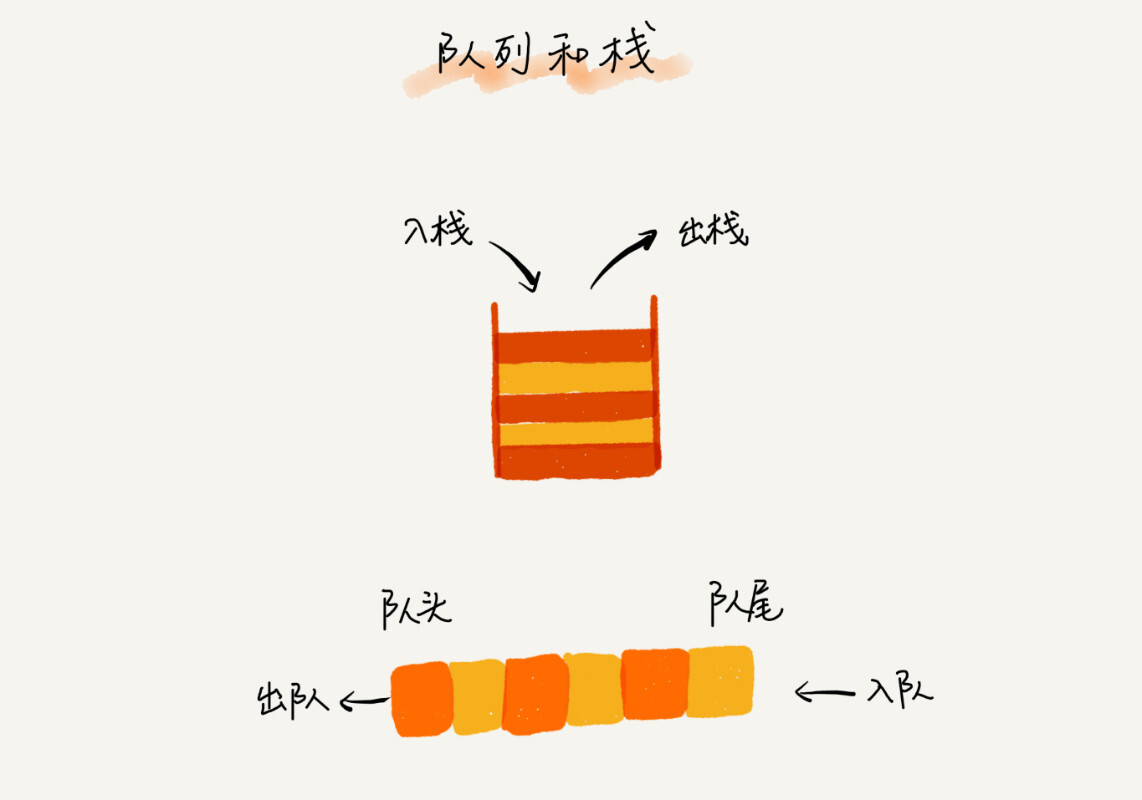
队列的应用非常广泛,线程次、连接池、消息队列、并发队列等。
顺序队列和链式队列
和栈一样,用数组实现的队列叫顺序队列,用链表实现的队列叫链式队列。
顺序队列
对于栈来说,只需要一个栈顶指针就可以了,而队列需要两个指针:一个 head 指针,指向对头;一个 tail 指针,指向队尾。假设 a, b, c, d依次入队,则 tail指针向后移动,如下图: 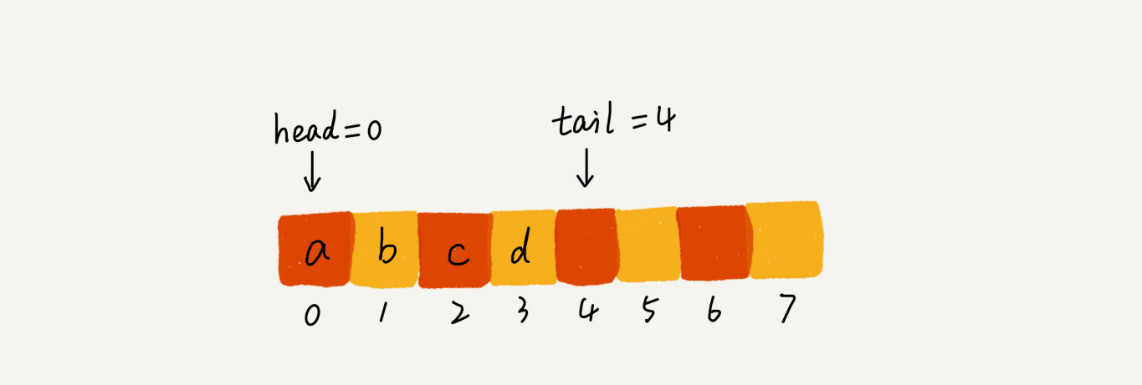
当调用 2 次出队操作后,head指针就指向了下标为 2 的位置: 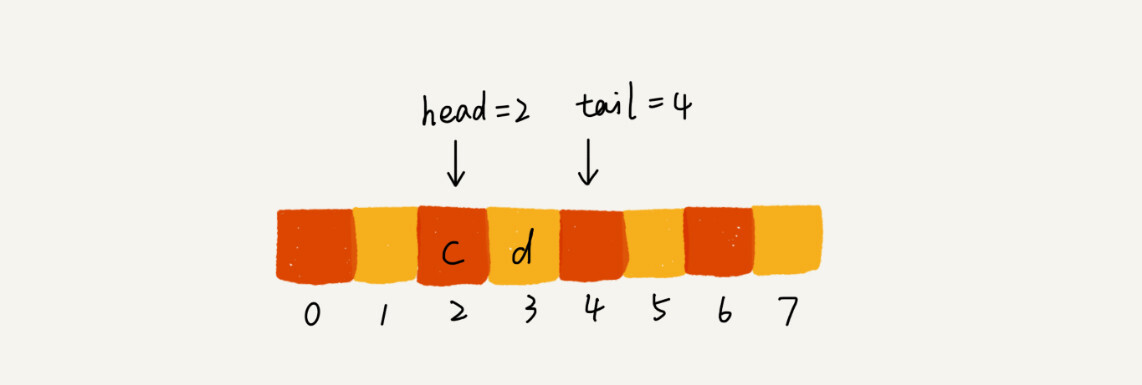
当 tail 指针移到了最右边,这时候就无法进行入队操作了,这种情况下需要触发一次数据搬移操作,把 head ~ tail之间的数据调整到 0 ~ (tail - head) 的位置。 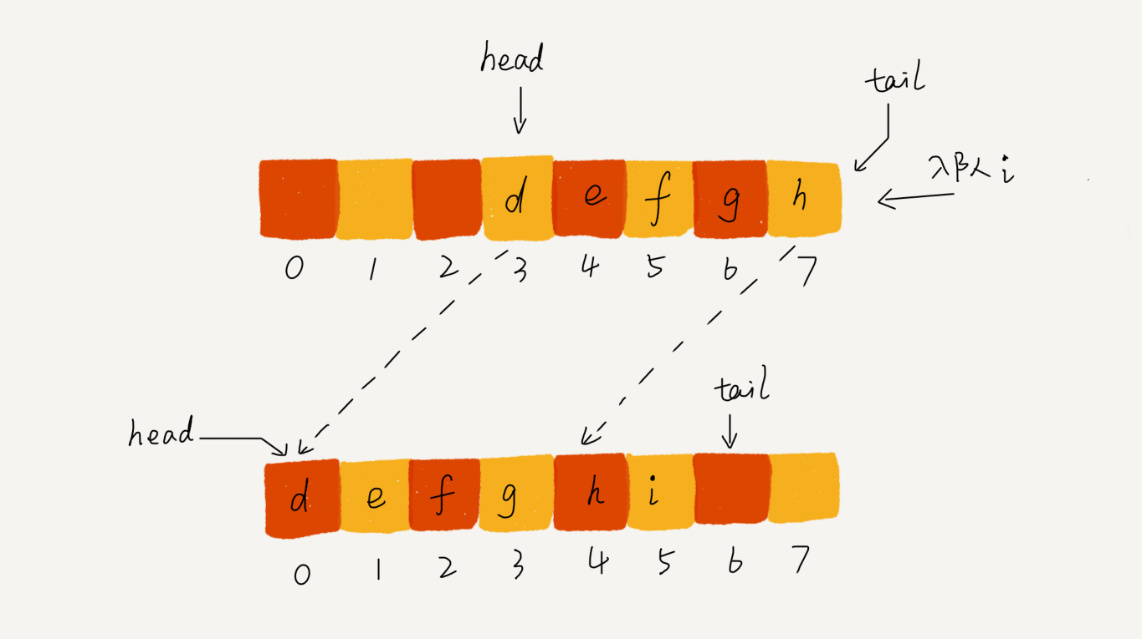
下面使用数组来实现一个顺序队列:
#!/usr/bin/env python
# -*- coding: utf-8 -*-
class ArrayQueue():
"""顺序队列"""
def __init__(self, capacity: int):
self.arr = []
self.capacity = capacity
self.head = 0
self.tail = 0
def enqueue(self, item):
if self.tail == self.capacity:
if self.head == 0:
print('队列满了')
return False
# 进行数据搬移
for i in range(self.head, self.tail):
self.arr[i - self.head] = self.arr[i]
# 重新调整指针和数组
self.tail = self.tail - self.head
self.head = 0
self.arr = self.arr[self.head: self.tail]
self.arr.append(item)
self.tail += 1
print('入队:', item)
return True
def dequeue(self):
if self.head == self.tail:
print('队列空了')
return None
item = self.arr[self.head]
self.head += 1
# self.arr = self.arr[self.head:]
print('出队:', item)
return item
def __repr__(self) -> str:
print('指针:', self.head, self.tail)
return '{}'.format(self.arr[self.head: self.tail])
if __name__ == '__main__':
arrayqueue = ArrayQueue(5)
arrayqueue.enqueue(2) #入队
arrayqueue.enqueue(3)
arrayqueue.enqueue(4)
arrayqueue.dequeue() #出队
arrayqueue.dequeue() #出队
arrayqueue.enqueue(5)
arrayqueue.enqueue(6)
arrayqueue.enqueue(7)
arrayqueue.enqueue(8)
arrayqueue.enqueue(9) #队列满了,入队失败
print(arrayqueue)
基于这种思路实现的出队操作时间复杂度为 O(1),入队操作最好情况时间复杂度为 O(1),只有在 tail 指针到达尾部时才会触发一次数据搬移操作,这时候时间复杂度为 O(n),随后进行正常入队,使用摊还分析法思路,均摊时间复杂度就为最好情况时间复杂度 O(1)。
链式队列
基于链表实现同样需要两个指针 head,tail
tail->next = new_node, tail = tail->next #入队
head = head->next #出队
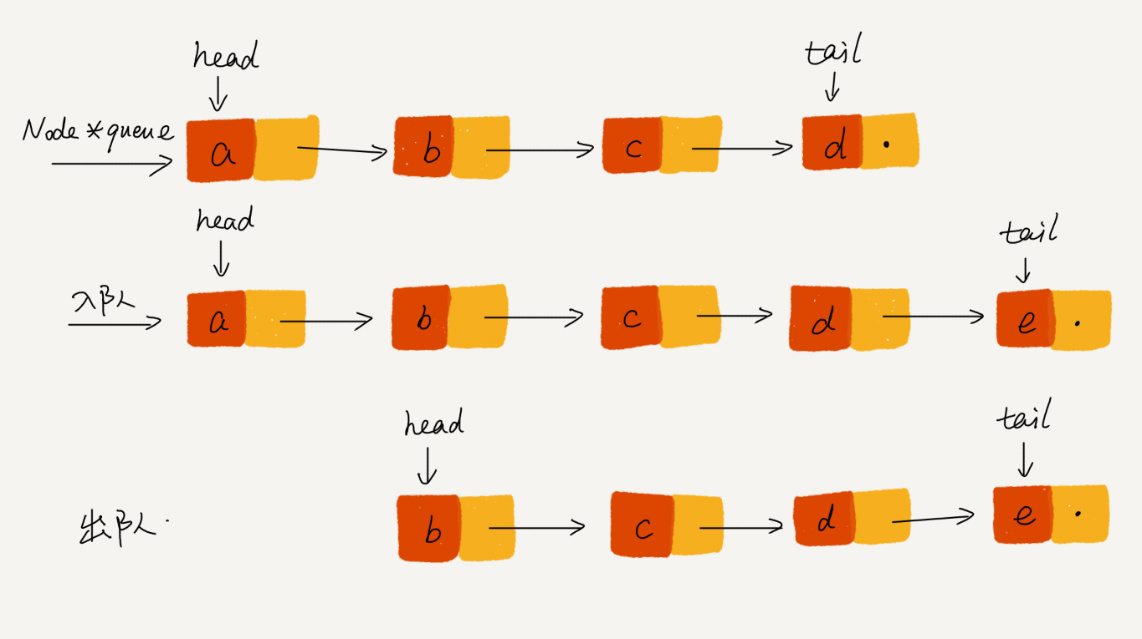
代码实现:
#!/usr/bin/env python
# -*- coding: utf-8 -*-
class Node:
def __init__(self, data, next=None):
self.data = data
self.next = next
class LinkedQueue:
def __init__(self):
self.head = None
self.tail = None
def enqueue(self, item):
new_node = Node(item)
if self.tail:
self.tail.next = new_node
else:
self.head = new_node
self.tail = new_node
return True
def dequeue(self):
if self.head:
item = self.head.data
self.head = self.head.next
if not self.head:
self.tail = None
return item
def __repr__(self):
items = []
base_node = self.head
while base_node:
items.append(base_node.data)
base_node = base_node.next
return "->".join(str(item) for item in items)
if __name__ == "__main__":
q = LinkedQueue()
for i in range(5):
q.enqueue(i)
print(q) # 0->1->2->3->4
for _ in range(3):
q.dequeue()
print(q) # 3->4
q.enqueue("5")
q.enqueue("6")
print(q) # 3->4->5->6
基于链表实现的入对和出队操作的时间复杂度都为 O(1)。
循环队列
在使用数组实现队列的时候,当 tail == n 的时候,会触发数据搬移操作,有没有办法可以避免数据搬移呢?可以使用循环队列这种数据结构来解决。 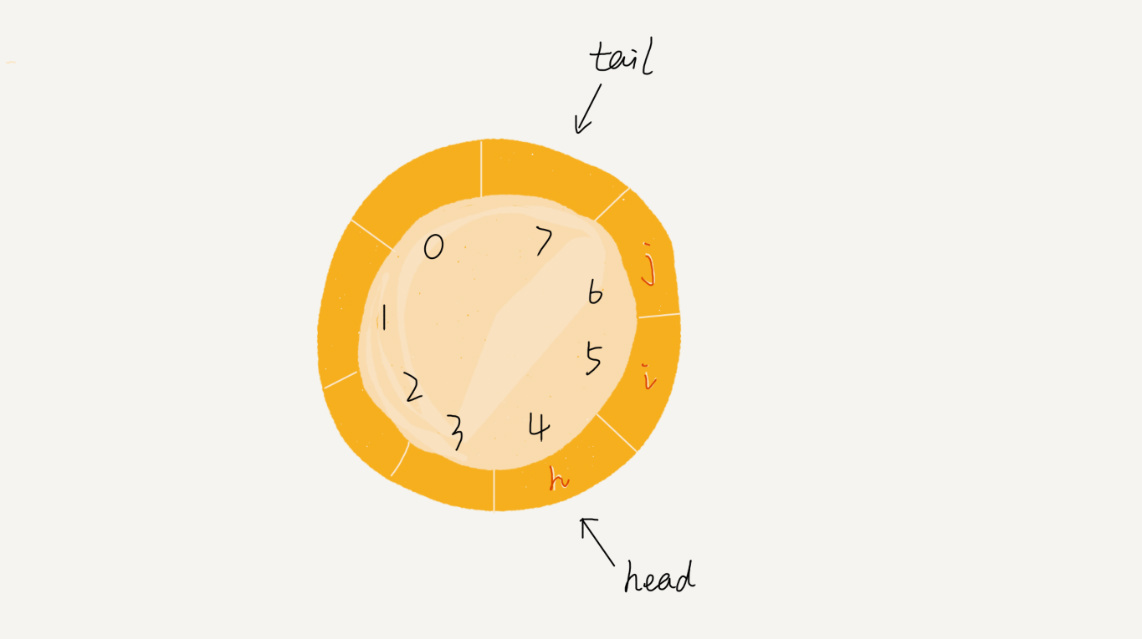
这个队列的大小为 8,当 tail = 7 时,如果有新的数据 a 入对,则把 tail 指针移到下标 0 的位置,再来一个数据 b,则把 tail 移到下标为 2 的位置: 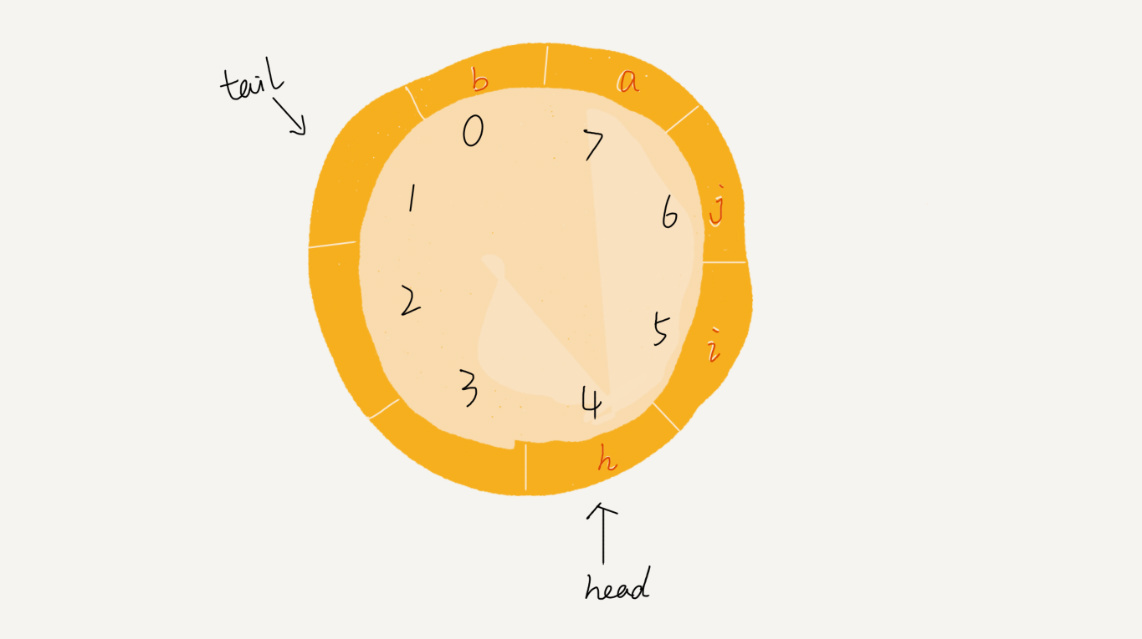
看起来很好理解,但实现起来比较难,难点在于判定队空和队满的的条件。看起来队空和队满的条件都是 tail == head,这显然不好判断。
实际上,我们浪费一个存储空间来存储 tail 指针,避免 tail 和 head 重合就好了,像这样: 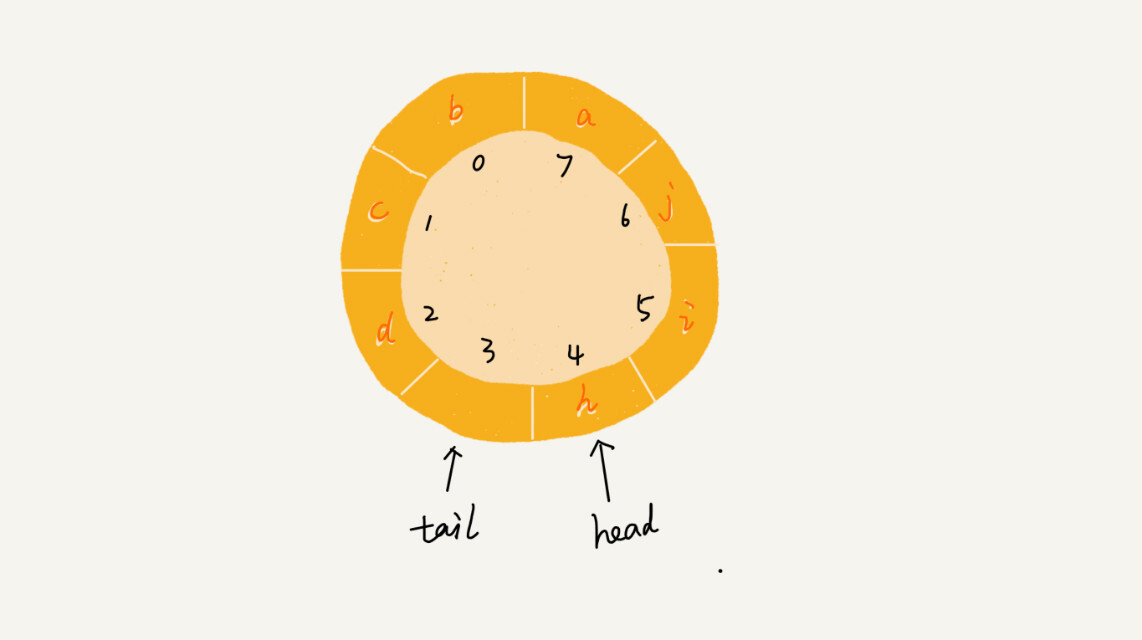
这时候队满的条件就是 (tail+1)%n=head。如 tail = 3,n = 8,head = 4,(3+1)%8=4。
代码实现:
#!/usr/bin/env python
# -*- coding: utf-8 -*-
class CircularQueue(object):
"""基于数组实现的循环队列"""
def __init__(self, capacity):
self.arr = []
self.capacity = capacity
self.head = 0
self.tail = 0
def enqueue(self, item):
n = self.capacity
if (self.tail + 1)%n == self.head:
print('队列满了')
return False
self.arr.append(item)
self.tail = (self.tail + 1)%n
return True
def dequeue(self):
n = self.capacity
if self.head == self.tail:
print('队列空了')
return False
item = self.arr[self.head]
self.head = (self.head + 1)%n
return item
def __repr__(self):
print('指针:', self.head, self.tail)
if self.head <= self.tail:
return "{}".format(self.arr[self.head: self.tail])
else:
return "{}".format(self.arr[self.head: self.capacity + self.tail])
if __name__ == '__main__':
Q = CircularQueue(8)
for i in range(7): # 实际只能存7个数据,最后一个存tail指针
Q.enqueue(i)
print(Q)
Q.dequeue()
Q.dequeue()
Q.dequeue()
Q.enqueue(7)
Q.enqueue(8)
Q.enqueue(9)
Q.enqueue(10) #入队失败,队列满了
print(Q)
应用
队列有哪些常见的应用?
1.阻塞队列
1)在队列的基础上增加阻塞操作,就成了阻塞队列。
2)阻塞队列就是在队列为空的时候,从队头取数据会被阻塞,因为此时还没有数据可取,直到队列中有了数据才能返回;如果队列已经满了,那么插入数据的操作就会被阻塞,直到队列中有空闲位置后再插入数据,然后在返回。
3)从上面的定义可以看出这就是一个“生产者-消费者模型”。这种基于阻塞队列实现的“生产者-消费者模型”可以有效地协调生产和消费的速度。当“生产者”生产数据的速度过快,“消费者”来不及消费时,存储数据的队列很快就会满了,这时生产者就阻塞等待,直到“消费者”消费了数据,“生产者”才会被唤醒继续生产。不仅如此,基于阻塞队列,我们还可以通过协调“生产者”和“消费者”的个数,来提高数据处理效率,比如配置几个消费者,来应对一个生产者。
2.并发队列
1)在多线程的情况下,会有多个线程同时操作队列,这时就会存在线程安全问题。能够有效解决线程安全问题的队列就称为并发队列。
2)并发队列简单的实现就是在 enqueue()、dequeue()方法上加锁,但是锁粒度大并发度会比较低,同一时刻仅允许一个存或取操作。
3)实际上,基于数组的循环队列利用 CAS 原子操作,可以实现非常高效的并发队列。这也是循环队列比链式队列应用更加广泛的原因。
3.有限资源池请求排队时的处理
比如线程池、数据库连接池资源的请求。
实际上,在资源有限的场景,当没有空闲资源时,基本上都可以通过“队列”这种数据结构来实现请求排队。
本文首发于 turbobin’s Blog 。转载请注明出处,附上本原文链接, 谢谢合作。

关注微信公众账号「曹当家的」,订阅最新文章推送